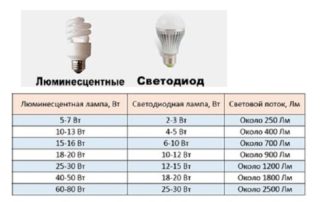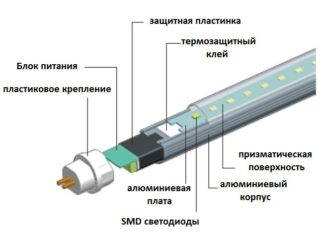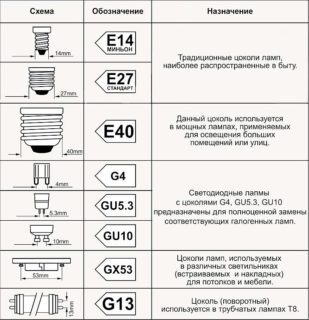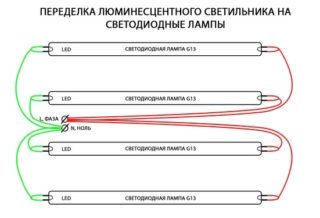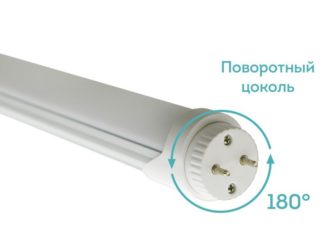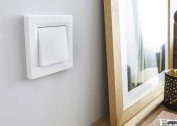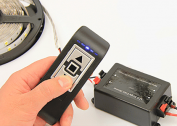If the fluorescent lamp is out of order or starters are constantly on, do not rush to throw it away. The lighting device can easily be converted into an LED. Fluorescent and LED lamps have the same base. Replacing fluorescent lamps will significantly improve the optical and energy properties of an old lamp.
Benefits of replacing fluorescent bulbs with LED bulbs

An LED bulb of any form factor literally surpasses a lamp with phosphor sputtering in almost all characteristics. At the same time, the manufacturing technology of LEDs is constantly progressing, so LED lamps in the future will be even more perfect.
You can calculate the approximate savings from replacing a fluorescent lamp with an LED on the example of apartments.
The apartment uses 10 fluorescent lamps, each of which works for 3 hours a day, respectively, 90 hours a month. Thus, 10 lamps with a phosphor consume per month: 50 W x 90 hours x 10 bulbs = 45 kW. At a price of 5.5 rubles per kilowatt, the monthly maintenance of such lighting devices will cost the owner 247.5 rubles.
Practice has shown that in an average two-room apartment, when installing LED lamps instead of fluorescent, the electricity charge is reduced by 2-2.5 times. In winter, the efficiency is significantly higher, since the lamps are used for more than 3 hours.
An approximate calculation of the efficiency of LEDs: 10 W x 90 hours x 10 bulbs = 9 kW, which in terms of financial resources is 49.5 rubles. With a difference in the cost of a fluorescent lamp of 150-200 rubles and an average LED lamp of 250-300 rubles with a similar light output, it turns out that almost 1 lamp pays off every month. All 10 bulbs will pay off in the form of electricity costs in less than 1 year. Further, the owner will save about 2,000 rubles a year on energy consumption.
These are only approximate estimates, in practice, the savings figures can be significantly higher.
Calculation of the efficiency of replacing fluorescent lamps with LED
Replacing LED fluorescent lamps will be advisable not only from a financial point of view, but also in terms of efficiency.
Fluorescent lamps:
- The operational period is 2000 hours and depends on the number of inclusions, but not more than 2000 cycles.
- The luminous flux is distributed in all directions, as a result of which the luminaires need a reflector.
- The brightness when turned on increases gradually.
- The ballast creates network interference.
- The protective layer gradually degrades, which entails a decrease in luminous flux by 25-30%.
- Mercury vapor is present in the glass flask; therefore, it requires a careful attitude.
LED light:
- The service life is at least 10,000 hours, regardless of the number of inclusions.
- The luminous flux is directed in a specific direction.
- The maximum brightness is dialed immediately after turning on.
- The driver does not interfere with electrical networks.
- Over the entire life of the brightness is reduced by 10%.
- Significantly lower energy consumption.
- Full environmental friendliness and safety.
Luminous efficiency of LEDs is 2 times greater at the same level of energy consumption. Such lamps are less likely to fail. You can place any number of LEDs inside the bulb, which allows you to achieve the optimal degree of illumination. Instead of fluorescent lamps with a power of 18 watts, you can put LEDs with a power rating of 9 watts. Thus, the alteration of fluorescent lighting devices under the LEDs is justified entirely.
What needs to be redone

The overall performance of LED lamps is similar to the size of fluorescent, so the ceiling lamp itself does not have to be remodeled structurally. The changes concern only the internal wiring diagram. LED lamps operate directly from the network and do not need ballasts, so this unit must be removed from the lamp.
Alteration implies such actions
- starter removal;
- short circuit and subsequent ballast extraction;
- capacitor shutdown.
After carrying out these steps, you can begin to implement the final scheme of the lamp.
Before converting a fluorescent lamp to an LED, you need to pay attention to the type of base. They are rotary and rigidly fixed. The most versatile are the base type swivel. They can be put in any converted lighting device, regardless of the type of slots in the cartridge - horizontal / vertical. In addition, swivel caps allow you to change the angle of inclination of the light flux.
LED design
An LED tube is a transparent bulb made of plastic, inside of which there is a driver and a getinaks bar with LEDs mounted on it. For this reason, installing an external driver is not necessary. Such a lamp is connected to a standard 220 V network.
The LED daylight is equipped with a G13 socket. The lamp pins are connected to each other inside the bulb by means of a copper wire, so that voltage can be applied to any of the pins.
LED tubes are made with a length of 600 or 1500 mm. Their power varies between 9-25 watts. The light emitted can be either warm or cold. LEDs are 60-65% more economical in contrast to fluorescent lamps.
LEDs can have a variety of shapes. The most common design is the classic 5mm case. The top is equipped with a lens, and the lower part with a reflector. A crystal is placed inside the case, which emits light when a current passes through it.
The design of the LED is trivial: it has two outputs - an anode and a cathode. A parabolic reflector made of aluminum (reflector) is located on the cathode. Outwardly, it is similar to a bowl-shaped recess.
A key component of the LED is a semiconductor single crystal in which the pn junction occurs. The single crystal itself has a cube shape with dimensions of 0.3x0.3x0.25 mm.
The crystal is connected to the anode via a gold-plated wire jumper. The body is made of polymer, it is optically transparent and synchronously is a focusing lens. Together with the reflector, they set the angle of emission of the LED and the directivity of the light flux.
The advantages of LED lamps over fluorescent
The key advantage of LED lamps in comparison with fluorescent ones is complete environmental friendliness. In the design of LEDs, no substances harmful to humans are used, while mercury vapor is present in fluorescent bulbs.
The second important plus of the LED lamp is the absence of flicker, the frequency of which is noticeable to human eyes. In luminescent analogues, such an effect is present. LEDs operate on direct current, which prevents them from flickering.This advantage makes it possible to make LED lighting over rotational mechanisms, where fluorescent bulbs will cause rapid eye fatigue.
In order for the human eye to perceive the surrounding environment as naturally as possible, it is necessary that the lighting device guarantees high-quality color reproduction. In this characteristic, LED lamps outperform luminescent ones, since their emission spectrum is correct, as close to natural as possible.
The luminescent luminous flux seems “inanimate” and unnatural, as a result of which the eyes perceive individual colors incorrectly.
Varieties of lamps
Lighting fixtures highlighted by pins in the form of pins are indicated by the “G” symbol. The accompanying symbol numbers indicate the distance between the centers of the pins. If the numbers are two, the second indicates the diameter of the circle into which the pins must be connected.
A socket type G13 (the distance between the pins is 13 mm) can be connected to luminaires of the class LPO, Armstrong, LVO and others. Sometimes G13 lamps are marked as T8, their mounting contact element is similar.
LED lamps with G13 socket can be connected to a standard lamp with a fluorescent lamp.
Replacement Instructions
The scheme for converting the lamp from fluorescent to LED lamps is quite simple, even an inexperienced electrician can cope with it.
Algorithm of actions:
- disconnecting the circuit breaker and checking for lack of voltage;
- removing the lid of the lamp to access the components of the circuit;
- removal of the capacitor, starter and throttle from the electrical circuit;
- separation of wires going to the terminals of the cartridges. They need to be connected directly to the phase / zero wires;
- removal or isolation of the rest of the wiring;
- installation of an LED lamp and test inclusion.
To remodel fluorescent lamps with electronic ballast, it is necessary to unsolder or cut off the wiring that goes to the ballast and leaves it. Next, the phase / zero wires are connected to the wires of the lamp holders, both left and right. The connection itself must be insulated. In conclusion, you can replace the light source with an LED lamp and apply mains voltage to it.
Wiring diagrams
There are two main schemes for connecting LED lamps: No. 1 - on AC 220V; No. 2 - on AC 110V.
Scheme number 1
This option involves powering the lamps from a standard network at 220 V 50 Hz. In this case, it is necessary to remove from the lamp all the components of the ballast.
Procedure:
- blackout network;
- extraction of fluorescent lamps;
- removal of the old electronic circuit: ballast extraction, starter and ballast removal, capacitor shutdown;
- installation of LED lamps;
- network connection.

This scheme is the simplest and requires a minimum of time for alteration.
Scheme No. 2
This variation implies that electronic ballast will remain in the luminaire. Only the starter must be removed. In this case, the power of the LED lamps will be 110 V.
The algorithm of actions is as follows:
- blackout network;
- extraction of fluorescent lamps;
- starter removal;
- installation of LED lamps;
- at the end, power is supplied.
This scheme is less popular, since with it the energy consumption of the lamps will be higher than with the first option. Accordingly, the saving effect will not be so noticeable.

Work with a cartridge
The lampholders can be installed in different ways: horizontally or vertically, in some models at an angle. Since fluorescent lamps illuminate 360 degrees, it does not matter for them how they will be installed in the cartridge.
The luminous flux of LED-type lamps is directional, so here you need to pay attention to the placement of the slots in the cartridge. It may happen that the luminous flux of the connected lamps will be directed not down, but to the side.In this case, the most universal will be the base of the rotary type. They are suitable for any models of fixtures and allow you to adjust the direction of light.
